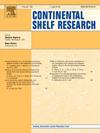西西里岛,爱奥尼亚海Marzamemi近海的中厚叶树滩:一个生境分类模型
IF 2.2
3区 地球科学
Q2 OCEANOGRAPHY
引用次数: 0
摘要
介孔自生栖工程师的发生和分布对海洋资源的有效管理和保护以及人类活动的调节具有重要意义。最近在地中海的深海勘探发现了藻礁(珊瑚)的出现,以及无脊椎动物在形成珊瑚礁方面的显著贡献。作为CRESCIBLUREEF项目的一部分,我们使用综合声学测量和水下视频对Marzamemi(爱奥尼亚海)近海30至100米的区域进行了调查。本研究详细描述了与密集种群相关的声相特征,这是一种脆弱的树状硬核珊瑚,包括在冷水珊瑚群中,被认为是栖息地。D. ramea分布于泥质-砂质沉积环境中65 ~ 90 m的深度,形成小的礁状河岸,斑块状分布的菌落大小从小于10 cm到大于50 cm不等,通常分布在埋藏的生物硬基质上,占地面积约0.42 km2。D. ramea作为一个自生的栖息地工程师,支持丰富的底栖生物组合,包括丰富的新齿蛾耳蜗。然而,海洋垃圾的证据,特别是缠绕珊瑚的废弃绳索,表明可能来自捕鱼活动的人为影响。通过识别D. ramea的声学特征并通过原位观察验证,本研究成功地绘制了Marzamemi地区以前未记载的中鞘珊瑚群。我们的研究结果强调了D. ramea栖息地的生态相关性和脆弱性,强调了将其纳入海洋空间规划和保护策略的必要性。本文章由计算机程序翻译,如有差异,请以英文原文为准。
Mesophotic banks of Dendrophyllia ramea offshore Marzamemi (Sicily, Ionian Sea): a habitat classification model
The occurrence and distribution of mesophotic autogenic habitat engineers are critical for the effective management and conservation of marine resources, as well as for regulating human activities. Recent deep-sea explorations in the Mediterranean Sea have revealed the occurrence of algal reefs (coralligenous), alongside notable contributions from invertebrates in creating reefs. As part of the CRESCIBLUREEF project, we investigated a sector offshore Marzamemi (Ionian Sea), at depths between 30 and 100 m, using integrated acoustic surveys and underwater videos. This study presents a detailed characterization of the acoustic facies associated with a dense population of Dendrophyllia ramea, a vulnerable arborescent scleractinian coral included in the cold-water coral group and recognized as habitat-former. Found between 65 and 90 m of depth in a muddy-sandy sedimentary environment, D. ramea forms small reef-like banks with patchily distributed colonies ranging in size from less than 10 cm to over 50 cm, generally on buried biogenic hard substrates, occupying an area of approximately 0.42 km2. D. ramea functions as an autogenic habitat engineer, supporting rich epibenthic assemblages including abundant Neopycnodonte cochlear at the base of the colonies. However, evidence of marine litter, particularly abandoned ropes entangling the corals, indicates anthropogenic impacts, likely from fishing activities. By identifying the acoustic signature of D. ramea and validating it with in situ observations, this study successfully maps previously undocumented mesophotic coral banks in the Marzamemi area. Our findings underscore the ecological relevance and vulnerability of D. ramea habitats, highlighting the need for their inclusion in marine spatial planning and conservation strategies.
求助全文
通过发布文献求助,成功后即可免费获取论文全文。
去求助
来源期刊

Continental Shelf Research
地学-海洋学
CiteScore
4.30
自引率
4.30%
发文量
136
审稿时长
6.1 months
期刊介绍:
Continental Shelf Research publishes articles dealing with the biological, chemical, geological and physical oceanography of the shallow marine environment, from coastal and estuarine waters out to the shelf break. The continental shelf is a critical environment within the land-ocean continuum, and many processes, functions and problems in the continental shelf are driven by terrestrial inputs transported through the rivers and estuaries to the coastal and continental shelf areas. Manuscripts that deal with these topics must make a clear link to the continental shelf. Examples of research areas include:
Physical sedimentology and geomorphology
Geochemistry of the coastal ocean (inorganic and organic)
Marine environment and anthropogenic effects
Interaction of physical dynamics with natural and manmade shoreline features
Benthic, phytoplankton and zooplankton ecology
Coastal water and sediment quality, and ecosystem health
Benthic-pelagic coupling (physical and biogeochemical)
Interactions between physical dynamics (waves, currents, mixing, etc.) and biogeochemical cycles
Estuarine, coastal and shelf sea modelling and process studies.
 求助内容:
求助内容: 应助结果提醒方式:
应助结果提醒方式:


